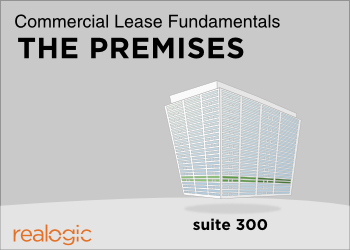 In last week’s article, we explored the different parties involved in commercial real estate leases and the roles each party is expected to play in a lease. For this post, I’ll tackle the intricacies of how Commercial Real Estate Leases define leased space, also known as the premises.
In last week’s article, we explored the different parties involved in commercial real estate leases and the roles each party is expected to play in a lease. For this post, I’ll tackle the intricacies of how Commercial Real Estate Leases define leased space, also known as the premises.
Premises Names
There is a standard set of information in every commercial real estate lease that defines what space the tenant has a right to possess. The first way a lease defines leased space is by unit or suite number.
These unique suite names are usually cut and dry in the initial lease, with naming systems that start from three digit numbers where the first number reflects the floor, and get more complicated from there.
Something to keep in mind with suite numbers though is that suite names can change in size over the course of a lease’s life. Sometimes, a lease will expand by redefining an expansion suite to be a part of the original suite name. In other cases, a lease may add a differently named suite under the lease that combines with an existing suite after the initial lease term expiration.
The Many Ways to Measure Square Footage
Commercial real estate leases often measure or quantify space by rentable square footage, although many government leases and other negotiated leases measure or quantify space on a usable basis. The definition of Rentable Square Feet is the usable square feet plus a load factor (i.e. a percentage, typically 7% to 20% depending on the layout of the building, of such common areas as the building lobby, common hallways and restrooms). Commercial Real Estate Leases also commonly provide a gross leaseable area, or GLA, meant to also reflect the usable space in the premises.
Rents are usually provided on a per square foot basis and increased by a percentage based on the initial rate but occasionally are spelled out as pure monthly amounts and increased on regular intervals. If the lease provides both the usable and rentable square footage, it is critical to identify which measurement Landlord is using to calculate the rent.
Summarizing Complicated Premises
Suffice it to say, keeping track of suite names and square footages in a commercial real estate lease over handfuls of amendments, expansions and subleases can be tricky. In my experience, I find it is usually is best summarized with a cheatsheet in the form of a timeline.
When I need to explain a complicated series of suite name and square footage changes, I do this exercise below. The degree of polish I use depends on whether this is something that will be of use for the next person who reads this lease or if it will just be a resource for myself.

In this example, I demonstrate how I would illustrate a lease that has an initial suite 100 with 4,000 rsf starting on 01/01/13 and ending on 12/31/2017, then expands on 01/01/2015 (suite 120: 1,000 rsf) and again on 01/01/2016 (suite 150: 1,000 rsf). Lastly, I demonstrate a not-uncommon term renewal and suite combination under the initially named Suite 100 premises.
Just doing this exercise once will help all who read the lease and ensuing documents understand the tenant’s leasehold space at glance, saving everyone time and brainpower for the really tricky parts of a lease.
Next Week: Basic Lease Information Part III: The Lease Term